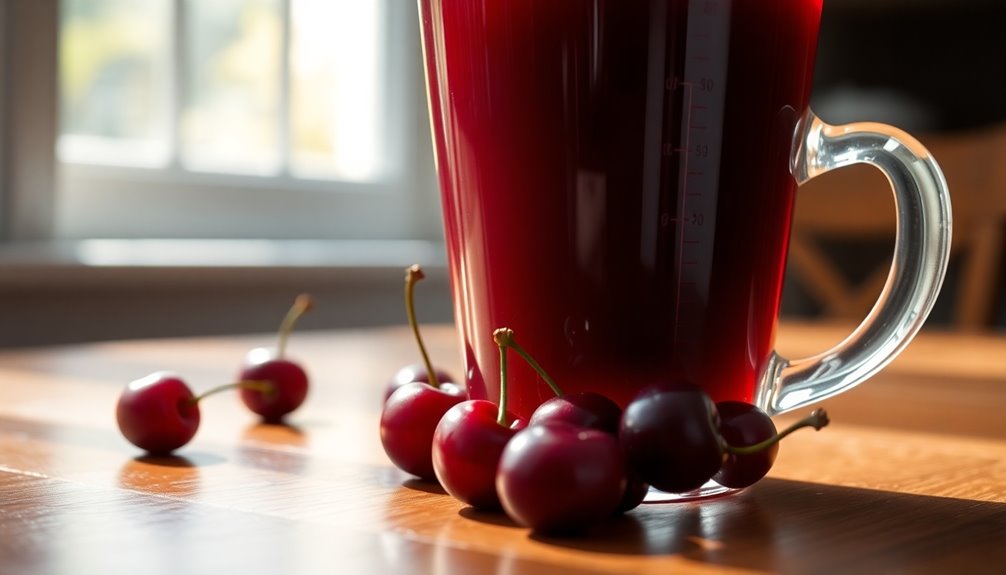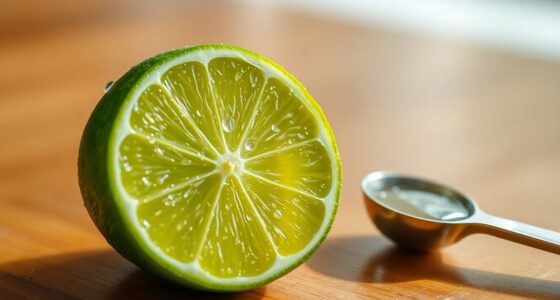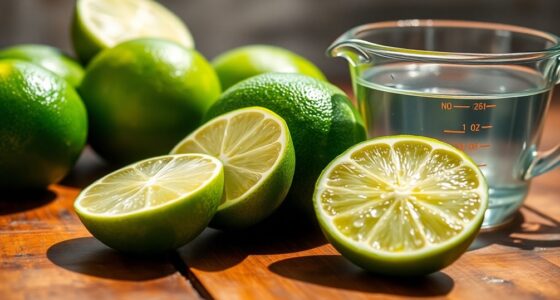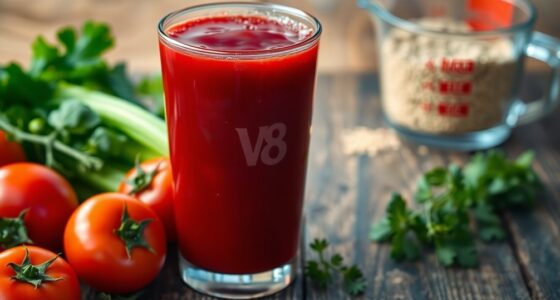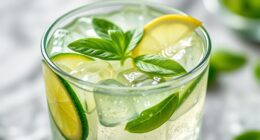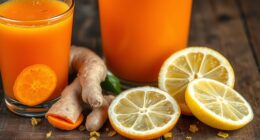To get the most health benefits from tart cherry juice, aim for a daily intake of 8 ounces. This serving size packs essential nutrients while keeping added sugars low. If you're an athlete, you might consider 10-12 ounces twice daily for recovery. Older adults can mix 1 ounce of concentrate with 7 ounces of water for an effective serving. Staying consistent is key, and there's more to discover about how it can enhance your wellness journey.
Key Takeaways
- For general health, consume 8 ounces of tart cherry juice daily to benefit from its nutrients and avoid excess sugar.
- Athletes may increase intake to 10-12 ounces twice daily for optimal recovery from exercise-related soreness and inflammation.
- Older adults can mix 1 ounce of concentrate with 7 ounces of water to create an 8-ounce serving that is easier to consume.
- Stick to 100% tart cherry juice without added sugars to maximize health benefits and minimize unnecessary calorie intake.
- Consistent daily consumption is key; monitor individual responses to determine the best serving size for your needs.

Are you wondering how much tart cherry juice you should drink for optimal health? You're not alone! Many people are curious about the right amount to consume, especially considering the numerous health benefits associated with tart cherry juice, particularly from Montmorency cherries. To maximize these benefits, understanding the recommended serving sizes is essential.
For general health, the typical serving size for tart cherry juice is 8 ounces. This amount is widely recommended as it provides a good balance of nutrients without overwhelming your system with excess sugar. When choosing your juice, make sure it's 100% tart cherry juice without added sugars. This way, you can fully enjoy the health benefits while minimizing unnecessary sugar intake.
If you're an athlete or someone engaged in heavy training, your needs might differ. Research suggests that consuming 10-12 ounces of tart cherry juice twice daily can be beneficial for exercise recovery. This larger intake helps reduce muscle soreness and inflammation, making it a popular choice among fitness enthusiasts. Remember, when you're in a recovery phase, providing your body with the right nutrients is crucial.
For older adults, tart cherry juice can also be beneficial. However, the serving approach is slightly different. A convenient method for older adults is to mix 1 ounce of tart cherry juice concentrate with 7 ounces of water to achieve the recommended 8-ounce serving. This dilution still provides the essential nutrients while making it easier to drink. It's a great way to include the juice in your daily routine without feeling overwhelmed by the flavor.
When preparing your juice, it's important to adhere to the U.S. Government guidelines, which recommend a 7-to-1 dilution for advertising 100% pure juice. This means you can feel confident that you're getting a consistent product that meets health standards. The dilution not only helps with taste but also ensures you're not consuming too much concentrated juice at once.
Additionally, many people overlook the importance of checking labels. Always opt for 100% tart cherry juice, as other products might contain added sugars that can diminish the juice's health benefits. Consuming juice with added sugars can lead to unnecessary calorie intake, which might counteract the positive effects you're aiming for.
Frequently Asked Questions
How Much Tart Cherry Juice Can You Drink a Day?
You can safely drink up to 16 ounces of tart cherry juice daily. This amount allows you to enjoy its health benefits without overdoing it. Tart cherry juice is rich in antioxidants and can help reduce inflammation, making it a popular choice for athletes and health enthusiasts alike. When incorporating tart cherry juice into your daily routine, it’s essential to consider its freshness to maximize its health benefits; typically, tart cherry juice shelf life is around 7-10 days after opening if stored in the refrigerator. To ensure you reap the most benefits, consume it regularly and watch for signs of spoilage.
If you're an athlete or training hard, consider having 10-12 ounces twice a day for optimal recovery.
Just make sure you choose juice without added sugars to keep your intake healthy. Staying within these guidelines will help you maximize the positive effects while avoiding excessive sugar consumption.
How Much Cherry Juice to Drink for Inflammation?
To reduce inflammation, you'll want to drink about 10 to 12 ounces of tart cherry juice twice daily.
This amount has been shown to significantly lower inflammatory markers in your body. By incorporating this juice into your routine, you may experience a 49% reduction in inflammation, which is especially helpful if you're dealing with arthritis or gout.
The antioxidants in the juice can support your overall joint health and mobility long-term.
Should You Dilute Tart Cherry Juice?
You might love the bold flavor of tart cherry juice, but diluting it can enhance your experience.
While the pure taste packs a punch, mixing it with water softens the tartness without sacrificing health benefits.
By adjusting the dilution, you can tailor the flavor to your liking—strong or mild.
Is It Better to Drink Tart Cherry Juice at Night or in the Morning?
Whether you drink tart cherry juice at night or in the morning depends on your health goals.
If you're looking to enhance your sleep quality, sipping it an hour before bed might be best.
However, if you want an antioxidant boost and support for exercise recovery, morning consumption is ideal.
Both options offer unique benefits, so consider your lifestyle and what you're aiming to achieve when deciding the best time for you.
Conclusion
Incorporating tart cherry juice into your routine can be a delicious way to boost your health, but moderation is key. While some studies suggest 8 to 12 ounces a day may help with muscle recovery and sleep, it's important to listen to your body. The theory that tart cherry juice can significantly improve your performance is backed by research, but individual responses may vary. So, start with a small amount and see how it works for you!
Cindy thoroughly researches juicing trends, techniques, and recipes to provide readers with practical advice and inspiration. Her writing style is accessible, engaging, and designed to make complex concepts easy to understand. Cindy’s dedication to promoting the advantages of juicing shines through her work, empowering readers to make positive changes in their lives through the simple act of juicing.

